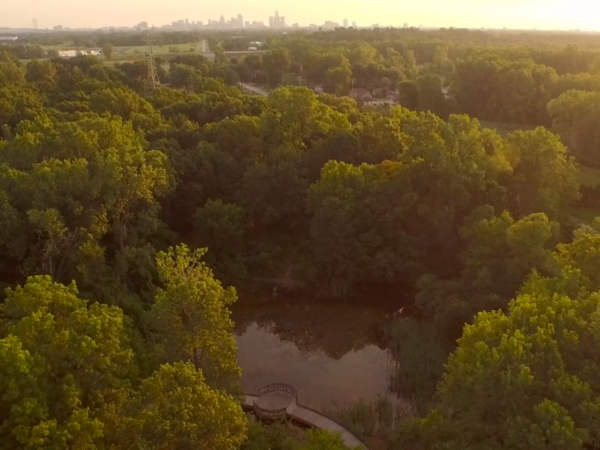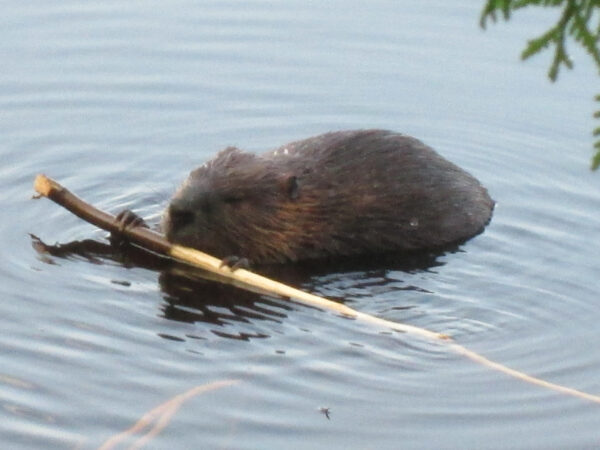
Editor’s Note: “Nibi Chronicles,” a monthly Great Lakes Now feature, is written by Staci Lola Drouillard. A direct descendant of the Grand Portage Band of Ojibwe, she lives and works in Grand Marais on Minnesota’s North Shore of Lake Superior. Her two books “Walking the Old Road: A People’s History of Chippewa City and the Grand Marais Anishinaabe” and “Seven Aunts” were published 2019 and 2022, and she is at work on a children’s story. “Nibi” is a word for water in Ojibwe, and these features explore the intersection of indigenous history and culture in the modern-day Great Lakes region.
Welcome to April in the north woods, which is accompanied by lingering snowstorms, the reemergence of chipmunks and the sound of Gijigijiganeshiinh — the Black-Capped Chickadee, singing their songs of spring. Here in Ojibwe Akiing, this time is known as Iskigamizige Giizis, or the Sap Boiling Moon.
Keep in mind that the Ojibwe seasonal calendar does not fit neatly into a grid of 30 days, give or take. What I’ve learned from Professor Gordon Jourdain, a Lac la Croix first-speaker of the Ojibwe language and very generous teacher, is that the Gregorian way of organizing time doesn’t correspond at all with the Anishinaabeg view, which tracks time based on the emergence of full moons. This means that the Ojibwe “calendar” has thirteen moons or “months,” not twelve, explains Professor Jourdain, director of the Waadookodaading Ojibwe Language Institute in Lac Courte Oreilles, Wisconsin. This year, Iskigamizige Giizis began on April 6 and will end on May 5, with the emergence of Waabigwani Giizis, or the “Flower Moon.” Iskigamizige Giizis is the official start of sap boiling here on Good Harbor Hill.
This is our second year tapping trees in the modest stand of Maples that we currently care for. Even though these trees are within the boundaries of our surveyed and sanctioned “property,” I am loathe to ascribe ownership over living things — including trees. I’d no sooner “own” a tree, than I would “own” a person. In the Ojibwe way, Aninaatigoog are our friends, teachers and fellow beings who have the extraordinary gift of generating sap in the spring. And as any pancake fan knows, maple sap turns into syrup, but only if you apply the right amount of heat and tender-loving-care.
The sugarbush is about a ten-minute walk from the edge of our yard and consists of mixed-woods, wetlands and hills. We’ve been meticulously packing the trail to and from the tap line, in order to avoid “post-holing” into waist-deep snow, unable to extract yourself without the help of a friend — which is what happened to me last year, before we learned to maintain it with a daily snowshoe trek.
Nothing lost in translation
Professor Jourdain talks about how long ago, the Anishinaabeg, the trees and the animals all used to speak the same language. He said that it is good to go out and speak to the trees even before you start tapping, in order to introduce yourself and thank them for their gifts. Today the snow is hard and crunchy, still mostly frozen by continuing low temperatures at night. There is no wind and as you climb the hill to the edge of the maple forest the sound changes — it feels quieter here, surrounded by the cathedral of trees.
“Boozhoo Akiwenzi Aninaatig,” hello old man Maple, I say to the biggest tree in the sugarbush. Its bark is thick, deeply etched, and is nearly black—much darker than a lot of the younger trees. This tree is already known as a good producer, and if we were so inclined, we might even drill two taps into the base of the tree, if we were interested in collecting more than we really need.

Sap boiling. (Photo Credit: Staci Lola Drouillard)
The single tap drips steadily, the sap clear and luscious — a delicacy for humans and sleepy chipmunks who must wake up thirsty after a long winter. The process of collecting sap is simple: When the night temperatures are below freezing, but day temperatures warm up into the 40s or 50s, we set out for the sugarbush, with kinickinick to offer each tree and a packsack with a few tools.
After greeting the tree and making an offering, a small hole is drilled in the bark, never too deep, or too close to last year’s drill scar. The metal taps are ingeniously designed and somewhat foolproof. There is a little hook on the top of the tap where you hang a plastic bag that is secured with a metal frame. We put Lake Superior rocks in the bottom of each bag to deter it from blowing off the hook in a big wind.
The tap design is based on the old way of creating spiles out of wooden wedges, like the ones that my Great Aunt Kate Frost would make every spring. The Drouillard-Anakwad sugarbush was north of Grand Marais, not far from what is still known as “Maple Hill.” This is where Kate and her family, including her sister, my Great Grandmother Elizabeth, would return every Iskigamizige Giizis to set up camp. It was a family tradition that required help from all ages.
Back then the sap was collected in birchbark vessels or makakoon. The Anakwads would pour the sap from the makakoon into metal bucks and carry it up the hill to camp, where it would get boiled over a steady fire. One of the most valued tools both 120 years ago and today, is a proper boiling kettle. Set over a good fire, the moisture evaporates until the sap is reduced into amber-colored syrup. Keep it on the fire for a bit longer and it transforms into taffy, a favorite treat of Jim Wipson’s.
Gathering sap come hell or driving snow
Jim was my elder cousin who told me the story of going to sugarbush with his grandmother Kate for my book, Walking the Old Road. It was one of his favorite childhood memories and I think of him and all the Anakwads every time I am working in the sugarbush or standing around the barrel stove watching the sap bubble away.
One of the astonishing things that I learned when researching family history, is the story of how, one year in early April, Great Grandmother Elizabeth bundled up all twelve of her children and herded them on foot towards Maple Hill, despite warnings that a spring snowstorm was about to hit the North Shore. Great Grandfather John Drouillard reportedly tried to keep her from going, but to no avail. Come hell or driving snow, nothing could keep her from the vital work of gathering sap.
Great Grandma’s efforts to keep the tradition of Iskigamizigewin in the family is not lost on me. Every drop of the precious sap represents a meaningful and monumental effort to honor those who came before us — those people and trees who continue to give generously of themselves, for the good of the people.
“Apichi go miigwech,” I say to Akiwenzi Maple. Which means “thank you very much.” I know in my heart that the old tree can hear me, and understands.
Catch more news at Great Lakes Now:
Nibi Chronicles: Acknowledging one family’s knack for finding ancient stone tools
Nibi Chronicles: Standing strong with mushers on the North Shore of Lake Superior
Featured image: Modern tap. (Photo Credit: Staci Lola Drouillard)




